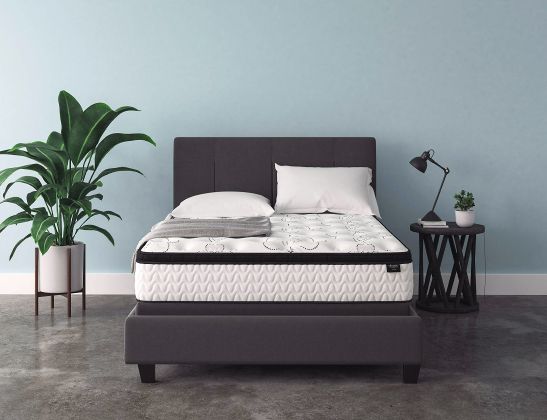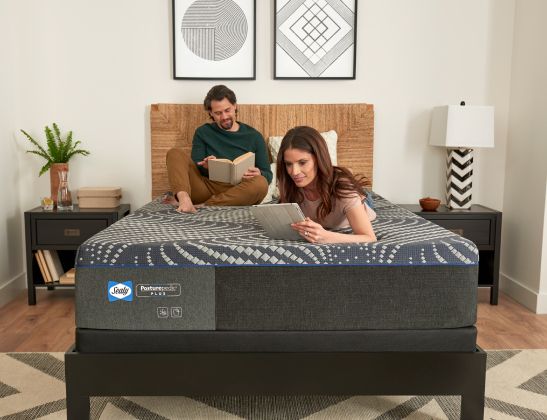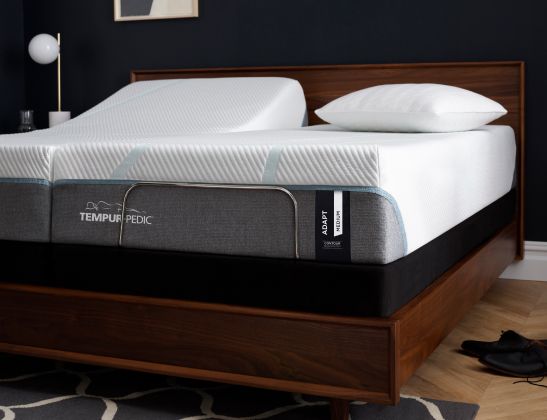The Ultimate Guide to Buying a New Bed: Understanding Bases, Box Springs, and Mattresses
Posted: May 9, 2024
Tired of tossing and turning? Finding the perfect bed can be tough, but a good night's sleep is within reach. In this ultimate guide to buying a bed, we'll break down everything you need to know about finding the perfect mattress for a better night's sleep.
This helpful guide goes beyond just mattresses. We'll help you choose the right base or foundation for proper support and explore how you can transform your slumber.
So, let's ditch the sleep struggles and gain restful nights and energized mornings!

Understanding the Foundation: Bases and Box Springs
A solid foundation does more than just support your mattress; it affects the comfort and feel of your bed. A good base can also minimize noise and preserve the effectiveness of the mattress's design.
Additionally, a strong base prevents your mattress from sagging in the center, a common culprit behind uncomfortable pressure points and misaligned spines. On the flip side, an inadequate base can decrease a mattress’s lifespan and diminish sleep quality.
Bed bases come in several types, each offering different benefits:
• Slatted Bases: These are usually made from wooden slats spaced evenly across the frame. They provide good ventilation to the mattress and help prevent moisture and mold buildup.
• Solid Platforms: These bases provide a firm, flat surface, ideal for memory foam or latex mattresses. The uniform support helps maintain the shape and integrity of the mattress.
• Adjustable Bases: Increasingly popular, adjustable bases allow you to adjust the position of your mattress, perfect for those who enjoy reading in bed or need elevation for health reasons.
Box springs are a traditional bed base featuring a wooden frame with springs or metal rods that provide bounce-back support to the mattress. Here are some reasons why you might choose a box spring instead of a base:
• Shock Absorption: Box springs reduce the wear and tear on your mattress by absorbing impact. This can extend the life of your mattress and improve comfort.
• Height and Support: Box springs raise the mattress off the ground to a more comfortable height, making it easier to get in and out of bed. Additionally, they can provide a flat and firm structure for the mattress to lie on, which is ideal for spring mattresses.
• Improved Air Circulation: The elevation provided by box springs allows for better air circulation around the mattress, which helps keep the bed cool and dry.
Keep in mind that choosing the right foundation isn’t just about preference. It's about enhancing the performance of your mattress and making sure you get a restful night's sleep.
Choosing the Right Mattress for Optimal Comfort
A good night's sleep starts with the right mattress. But with so many options available, choosing the perfect one can feel overwhelming. Don't worry! We’ll break down the most popular types of mattresses and how to pick the firmness that best suits you.
Mattress Types:
• Memory Foam: Known for its pressure-relieving comfort, a memory foam mattress cradles your body and minimizes aches and pains. This is ideal for side sleepers and those with joint issues.
• Innerspring: The classic choice, innerspring mattresses offer a bouncy feel and firm support. Perfect for back and stomach sleepers who prefer a traditional sleeping surface.
• Hybrid: Combining the plush comfort of memory foam with the supportive core of innerspring, hybrid mattresses cater to a wider range of sleepers.
• Latex: Offering a similar contouring feel to memory foam but with more bounce, latex mattresses are durable and resistant to dust mites and allergens. They’re a great choice for eco-conscious consumers and those who prefer a cooler sleep.
Find Your Sleep Style:
• Side Sleepers: Opt for a medium-soft to medium-firm mattress to provide ample cushioning for your shoulders and hips.
• Back Sleepers: Medium-firm to firm mattresses offer the best lumbar support for a healthy spinal alignment.
• Stomach Sleepers: Firmer mattresses keep your hips elevated and your spine aligned, promoting better posture during sleep.
• Combination Sleepers: A versatile medium-firm mattress is a good starting point, as it offers a balance of comfort and support for various sleeping positions.
Don't Forget Size and Thickness:
• Mattress Size: Choose a mattress size that fits comfortably in your bedroom and accommodates your body type. From cozy Twins to luxurious California Kings, there's a perfect size for everyone.
• Mattress Thickness: Mattress thickness can range from 6 to 14 inches. Thicker mattresses generally provide more support and a plusher feel, which is ideal for heavier sleepers or those seeking extra luxury.
Practical Tips for Mattress Shopping
Navigating the mattress-buying process can be surprisingly smooth with the right approach. To transform your mattress hunt from a chore into a confident buying experience, consider these useful tips:
• Do Your Research: Before heading to the store or browsing online, familiarize yourself with the different types of mattresses, materials, and technologies available using our guide.
• Set a Budget: Mattresses come in a wide range of prices, and it’s important to set a realistic budget before you start shopping. Remember, a high price doesn’t always equate to higher quality, but it's also true that a good mattress is an investment in your health.
• Test the Mattress: If possible, visit a store to test mattresses firsthand. Spend at least 10-15 minutes on each mattress in your preferred sleeping position to get a true feel for its comfort and support. This hands-on testing can be invaluable in making your final decision.
• Read Reviews: Look up customer reviews and ratings for the mattresses you are considering. Feedback from other users can provide insight into the mattress’s durability, comfort, and customer satisfaction over time.
• Check the Return Policy and Warranty: Always check the retailer’s return policy and the product warranty. A good return policy allows you to try the mattress at home with the option to return it if it doesn’t meet your expectations. Similarly, a comprehensive warranty protects your purchase against defects or issues down the line.
• Consider the Size and Thickness: Make sure the mattress fits well in your bedroom and suits your body size and weight. Also, consider the thickness of the mattress, as this can affect the bed's overall height and the ease of getting in and out every morning.
• Shop at the Right Time: Keep an eye on your calendar! Mattress sales often coincide with major holidays like Presidents' Day, Memorial Day, and Black Friday. Planning your purchase around these times can lead to huge savings.
Caring for Your Mattress and Extending Its Life
Investing in a good mattress is like investing in your health and happiness. After all, a good night's sleep is the key to feeling your best during the day. But just like any investment, proper care is crucial to ensure your mattress delivers years of blissful sleep. Here are some essential tips to keep your mattress feeling fresh and supportive for longer:
• Use a Mattress Protector: One of the simplest and most effective ways to protect your mattress is by using a mattress protector. These protectors act as a barrier against dust, spills, and contaminants. They can also protect against wear and tear and are usually machine washable.
• Rotate Your Mattress Regularly: At a minimum, you should rotate your mattress every three months. This helps prevent one side from sagging, evenly distributes the fillings, and ensures balanced wear on both sides of your mattress.
• Keep the Mattress Clean: Regularly clean your mattress to remove dust and allergens. Vacuuming your mattress every few months with an upholstery attachment can help keep it fresh. For stains, use mild soap and cold water, and spot clean as needed. Always allow the mattress to dry completely before putting your bedsheets back on.
• Ensure Proper Support: Make sure your mattress is supported properly by a sturdy bed frame or base. This support helps prevent sagging and maintains the integrity of the materials. Check the manufacturer’s recommendations for the type of support needed for your specific mattress type.
• Avoid Bending or Folding: Never bend or fold your mattress, as this can damage the internal structure, especially for spring and foam mattresses. When moving your mattress, always keep it flat or upright on its side to keep it in the best possible condition.
• Be Mindful of Weight: Be aware of the weight guidelines for your mattress and avoid placing heavy objects on it for extended periods. This can include avoiding sitting in the same spot frequently, which can lead to uneven compression of the mattress materials.
• Replace When Needed: Even with the best care, every mattress has a lifespan. Most mattresses need to be replaced every 7-10 years. So, pay attention to signs of wear and tear, such as noticeable dips, decreased comfort, or a decrease in sleep quality, which indicate that it might be time for a new mattress.
Find Your Next Mattress at Silica
A good night's sleep isn't just a luxury; it's a necessity for your health and well-being. That's why choosing the perfect bed—base, box spring, and mattress—is an investment worth making.
Remember, a little research and testing go a long way in finding the ideal fit for your sleep style and budget. At Silica, we're committed to helping you achieve the best sleep, so don’t hesitate to contact us today with any questions.
Visit our Silica store locations in Fond du Lac, Beaver Dam, or Watertown, Wisconsin, to explore our wide selection of mattresses, bases, and other home essentials. Silica offers top-name brands like Tempur-Pedic, Stearns & Foster, Sealy, Bedgear, and more, so you can find the perfect mattress, pillow, sheets, or mattress protector for a great night's sleep. Elevate your home with the best products available and experience the comfort and quality you deserve.
FAQ
1. Is it worth buying a new bed?
Yes, a new bed can improve sleep quality and reduce pain, benefiting overall health.
2. How often should you replace your bed?
Replace your bed every 7-10 years, depending on its condition and your comfort level.
3. Where do I start when buying a new bed?
Begin by evaluating your sleep preferences, and comfort needs, and read reviews on different bed types and brands.
4. How often should you change your bed?
Change bedding weekly or bi-weekly; replace the mattress approximately every 7-10 years.
5. What is the best type of mattress for back pain?
A medium-firm mattress is typically best for back pain, offering a balance of support and comfort.
6. Can a mattress affect allergies?
Yes, some mattresses, like those made from latex or with hypoallergenic covers, can help reduce allergens.
7. Should I choose a box spring or a platform bed?
Choose based on mattress type: box springs are ideal for spring mattresses for added bounce and durability, while platform beds suit memory foam and latex mattresses for stable support.
Featured Products
• Tempur-Pedic TEMPUR-LuxeBreeze® Medium Hybrid 2.0 - Queen Model# 102382QUEEN
• Sealy Carrington Chase - Excellence Love - Hybrid - Firm - Queen Model# 526724QUEEN



Be The First To Know
Sign up to get access to deals, inspiration, trends, and more!








